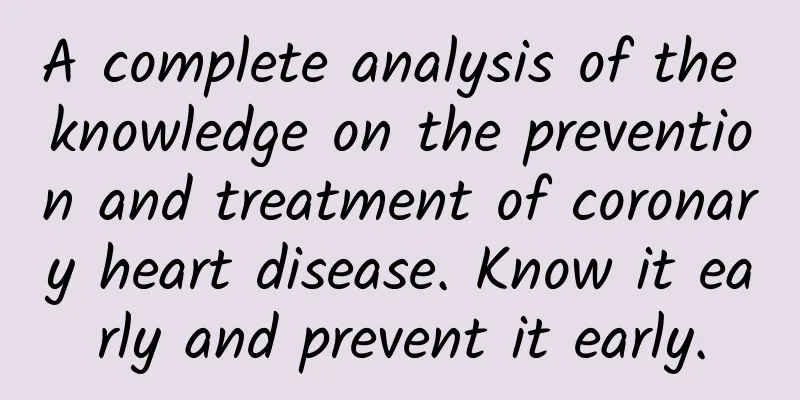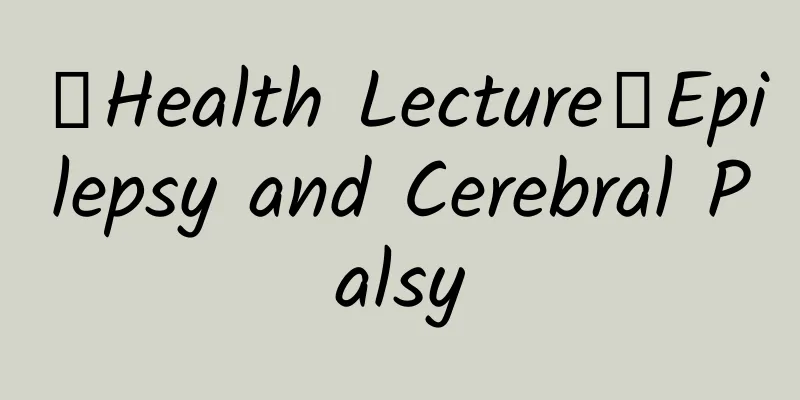A complete analysis of the knowledge on the prevention and treatment of coronary heart disease. Know it early and prevent it early.

|
Coronary heart disease, also known as coronary atherosclerotic heart disease, is a cardiovascular disease caused by coronary atherosclerosis. With the improvement of living standards and the arrival of an aging society, coronary heart disease has become one of the major diseases that threaten human health. We will introduce the causes, symptoms, risk factors, preventive measures and treatment methods of coronary heart disease to help everyone understand, prevent and treat it early. 1. Causes and pathological mechanisms of coronary heart disease The occurrence of coronary heart disease is mainly due to the appearance of atherosclerotic plaques on the inner wall of the coronary arteries (blood vessels that supply blood to the heart). These plaques are composed of lipids, cholesterol, calcium and other components. They gradually increase over time, causing narrowing or blockage of the blood vessel lumen, thereby affecting the blood supply to the myocardium, causing myocardial ischemia, hypoxia and even necrosis. In addition, coronary artery spasm may also lead to transient myocardial ischemia, causing symptoms such as angina pectoris. 2. Symptoms of coronary heart disease The symptoms of coronary heart disease vary, but the most typical one is angina pectoris, which is a compressive, tight or burning pain in the precordial area or behind the sternum, which can radiate to the left shoulder, inner left arm, neck or mandibular area. The pain usually lasts from a few minutes to more than ten minutes and can be relieved by resting or taking nitroglycerin. In addition to angina pectoris, coronary heart disease may also cause shortness of breath, syncope, chest tightness, chest pain, fatigue, cough, sputum and other symptoms. When the condition is serious, acute myocardial infarction may also occur, which is manifested by persistent severe chest pain, profuse sweating, a sense of impending death, etc., and medical attention should be sought immediately. 3. Risk factors for coronary heart disease The occurrence of coronary heart disease is the result of the combined effects of multiple factors. Understanding and controlling these risk factors is crucial to preventing coronary heart disease. The main risk factors include: Age and gender: Coronary heart disease is more common in middle-aged and elderly people over 40 years old. The incidence rate in men is higher than that in women, but the incidence rate in women has also been on the rise in recent years. Genetic factors: People with a family history of coronary heart disease have a higher risk of the disease, but genetic factors are not decisive, and lifestyle is equally important. Dyslipidemia: Hyperlipidemia is one of the most important risk factors for coronary heart disease, especially elevated low-density lipoprotein cholesterol (LDL-C). Hypertension: Long-term hypertension can damage the vascular endothelium and promote the formation of atherosclerosis. Diabetes and impaired glucose tolerance: High blood sugar not only affects microvessels, but also accelerates macrovascular disease and increases the risk of coronary heart disease. Smoking: Smoking is an independent risk factor for coronary heart disease, including passive smoking and secondhand smoke. Bad living habits: such as obesity, lack of exercise, high-salt and high-fat diet, staying up late for a long time, emotional stress, etc. 4. Preventive measures for coronary heart disease Improve your lifestyle Healthy diet: Patients with coronary heart disease should adhere to a low-salt, low-fat, and low-sugar diet and consume more fresh fruits and vegetables, which are rich in fiber and antioxidants and help reduce cardiovascular risks. At the same time, they should supplement with high-quality protein, such as fish, poultry, and soy products, to meet the body's nutritional needs. Avoid excessive intake of high-salt, high-fat, and high-sugar foods, such as pickled foods, fried foods, and sweet drinks, which may increase the burden on the heart and are not good for health. Quit smoking and limit alcohol consumption: Smoking is one of the main risk factors for coronary heart disease. Harmful substances in tobacco can damage the vascular endothelium and promote the formation of atherosclerosis. Therefore, patients with coronary heart disease should resolutely quit smoking and avoid exposure to secondhand smoke. At the same time, it is also important to limit alcohol intake, because excessive drinking may lead to increased blood pressure and heart rate, increasing the risk of cardiovascular events. It is best not to drink or only drink a small amount of low-alcohol alcohol. Moderate exercise: Regular exercise is essential for patients with coronary heart disease. It is recommended to do at least 150 minutes of moderate-intensity aerobic exercise per week, such as brisk walking, jogging, swimming, cycling, etc. These exercises can enhance cardiopulmonary function and improve body metabolism. At the same time, combined with resistance exercise and stretching exercises, such as weightlifting, yoga, etc., can further enhance muscle strength and flexibility, and help improve physical function. Control your weight: Maintaining an ideal weight is one of the important measures to prevent coronary heart disease. Obese people should lose weight through a proper diet and moderate exercise to avoid the cardiovascular risks brought by obesity. At the same time, they should regularly monitor weight changes and adjust their diet and exercise plans in a timely manner to keep their weight within a healthy range. Control underlying diseases Hypertension: Monitor blood pressure regularly, take antihypertensive medication as prescribed by your doctor, and keep blood pressure within the ideal range. Diabetes: Actively control blood sugar, including fasting blood sugar and postprandial blood sugar, and regularly monitor glycosylated hemoglobin. Dyslipidemia: According to the blood lipid level, lipid-lowering drugs such as statins, fibrates, etc. should be used rationally. Regular physical examinations and screenings For people with risk factors for coronary heart disease, it is recommended to have a comprehensive physical examination at least once a year, including blood pressure, blood sugar, blood lipids, electrocardiogram, cardiac ultrasound, etc., and coronary artery CTA or angiography if necessary. Take medication as directed by your doctor For patients who have been diagnosed with coronary heart disease, they should strictly follow the doctor's instructions to take medications, including antiplatelet drugs (such as aspirin), lipid-lowering drugs (such as statins), beta-blockers, etc., to prevent the progression of the disease and reduce the occurrence of cardiovascular events. 5. Treatment of coronary heart disease Drug treatment Drugs to improve symptoms: When patients with coronary heart disease experience symptoms such as angina pectoris, they can use nitrate drugs (such as nitroglycerin) to quickly dilate the coronary arteries and relieve angina pectoris. In addition, beta-blockers can also reduce myocardial oxygen consumption and alleviate the symptoms of angina pectoris. The use of these drugs should be in accordance with the doctor's advice, and pay attention to the side effects and contraindications of the drugs. Drugs to improve prognosis: In addition to drugs to relieve symptoms, patients with coronary heart disease also need to use drugs to improve prognosis to prevent disease progression and reduce the occurrence of cardiovascular events. Statins can lower cholesterol levels and stabilize plaques; antiplatelet drugs (such as aspirin) can prevent thrombosis and blood vessel blockage. The use of these drugs requires long-term persistence, and regular monitoring of changes in related indicators such as liver function. Interventional treatment For patients with severe coronary artery stenosis (up to 75%) and poor response to drug treatment, percutaneous coronary intervention (PCI) can be performed, which is to place a stent in the coronary artery to open the narrowed or blocked blood vessel segment and restore myocardial blood supply. Surgical treatment Coronary artery bypass grafting (CABG) is suitable for patients with multi-vessel disease, left main coronary artery disease or those who are not suitable for stent implantation. The surgery bypasses the narrowed or blocked area by taking blood vessels from other parts of the patient's body to restore the blood supply to the myocardium. Cardiac rehabilitation and secondary prevention Cardiac rehabilitation is an important part of the treatment of coronary heart disease, including exercise training, nutritional guidance, psychological intervention, smoking cessation and alcohol restriction, etc. Through comprehensive intervention, the patient's physiological, psychological and social functions are fully restored. VI. Conclusion Coronary heart disease is a preventable and controllable disease. The risk of disease can be significantly reduced by improving lifestyle, controlling underlying diseases, regular physical examinations and screening, and taking medications as directed by doctors. For patients with confirmed coronary heart disease, they should actively cooperate with doctors to control the progression of the disease through medication, interventional therapy, or surgical treatment. Let us start now, know early, prevent early, and treat early, and jointly protect heart health. In general, there is no need to be nervous if you have coronary heart disease. By taking medication regularly and living a healthy lifestyle, you can delay your life and improve your quality of life. Author: Dai Huiji, Guancheng Community Health Service Center, Dongguan City, Guangdong Province |
Recommend
How much do you know about the deformed central apex?
This is the 3827th article of Da Yi Xiao Hu A few...
Is vomiting a serious reaction to ectopic pregnancy?
In fact, patients with ectopic pregnancy are very...
Super detailed! All the frequently asked questions of tuberculosis patients are answered here
I have summarized the questions I have heard from...
How to get over the grief after abortion?
It is not an easy thing for a woman to get pregna...
Maintain a healthy weight and choose light meals
With economic development and the improvement of ...
A good way to remove blackheads for junior high school girls
Many girls will see a lot of blackheads growing o...
Can myopia and presbyopia be offset? Let's see what the ophthalmologist says!
“People with myopia will not get presbyopia!” &qu...
How to lose weight due to endocrine disorders and obesity, 4 ways to make you lose weight to the point of screaming
Under the influence of some bad habits, it is ver...
Can a pregnant woman drink alcohol?
Today's society is a communication society. S...
How to squeeze orange juice to make it taste good? Can orange juice help you lose weight?
Orange juice is the juice squeezed from the flesh...
Does eating spicy food during early pregnancy affect the fetus?
I believe that there are many female friends in o...
Tips for getting pregnant quickly
We all know that women's physiques will be mo...
Here is everything you want to know about alkaline vegetables
Vegetables in our daily life are also divided int...
Can I drink motherwort during menstruation?
Motherwort granules are a common medicine for tre...
Does regular drinking really cause liver cancer? How does cancer occur? For the sake of health, please quit drinking
China's "wine culture" has a long h...









